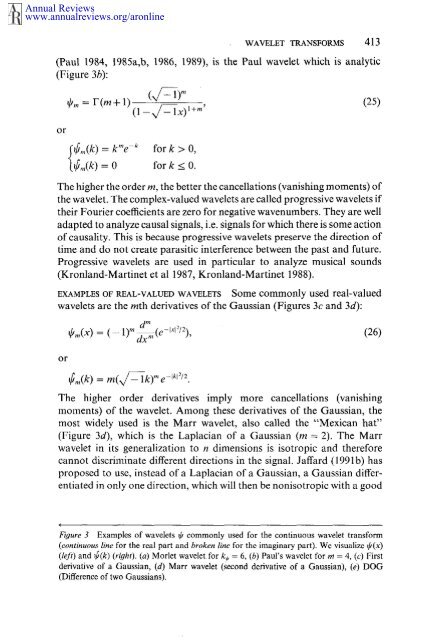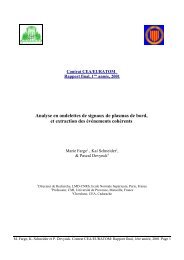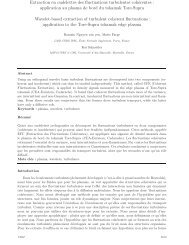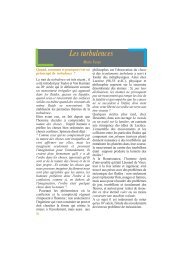wavelet transforms and their applications to turbulence - Wavelets ...
wavelet transforms and their applications to turbulence - Wavelets ...
wavelet transforms and their applications to turbulence - Wavelets ...
You also want an ePaper? Increase the reach of your titles
YUMPU automatically turns print PDFs into web optimized ePapers that Google loves.
Annual Reviewswww.annualreviews.org/aronline(Paul 1984, 1985a,b, 1986,(Figure 3b):WAVELET TRANSFORMS 4131989), is the Paul <strong>wavelet</strong> which is analytic~/m = F(m+l) (%~l)m(1 ’+m’ -,fS x)(25)or{~ m(k) kme k fork > 0,~,,,(k) = for k _< 0.The higher the order rn, the better the cancellations (vanishing moments)the <strong>wavelet</strong>. The complex-valued <strong>wavelet</strong>s are called progressive <strong>wavelet</strong>s if<strong>their</strong> Fourier coefficients are zero for negative wavenumbers. They are welladapted <strong>to</strong> analyze causal signals, i.e. signals for which there is some actionof causality. This is because progressive <strong>wavelet</strong>s preserve the direction oftime <strong>and</strong> do not create parasitic interference between the past <strong>and</strong> future.Progressive <strong>wavelet</strong>s are used in particular <strong>to</strong> analyze musical sounds(Kronl<strong>and</strong>-Martinet ct al 1987, Kronl<strong>and</strong>-Martinct 1988).EXAMPLES OF REAL-VALUED WAVELETS Some commonly used real-valued<strong>wavelet</strong>s are the ruth derivatives of the Gaussian (Figures 3c <strong>and</strong> 3d):orI[Im(X )= (-- 1) m ~(d--lx12/2), (26)ax~ffm(k)m(~-- lk) m e -Ikl2/2.The higher order derivatives imply more cancellations (vanishingmoments) of the <strong>wavelet</strong>. Among these derivatives of the Gaussian, themost widely used is the Marr <strong>wavelet</strong>, also called the "Mexican hat"(Figure 3d), which is the Laplacian of a Gaussian (m ~ 2). The<strong>wavelet</strong> in its generalization <strong>to</strong> n dimensions is isotropic <strong>and</strong> thereforecannot discriminate different directions in the signal. Jaffard (1991 b) hasproposed <strong>to</strong> use, instead of a Laplacian of a Gaussian, a Gaussian differentiatedin only one direction, which will then be nonisotropie with a goodFigure 3 Examples of <strong>wavelet</strong>s ~b commonly used for the continuous <strong>wavelet</strong> transform(continuous line for the real part <strong>and</strong> broken line for the imaginary part). We visualize ~b(x)(left) <strong>and</strong> ~(k) (right).(a) Morlet <strong>wavelet</strong>, for k~ = 6, (b) Paul’s <strong>wavelet</strong> for m = 4, (c) Firstderivative of a Gaussian, (d) Marr <strong>wavelet</strong> (second derivative of a Gaussian), (e)(Difference of two Gaussians).





